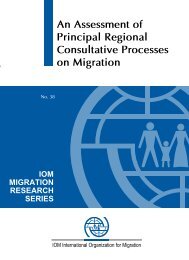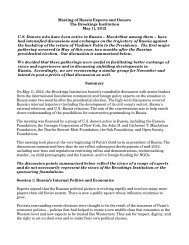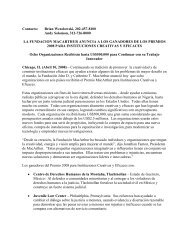A Global Compact on Learning - Brookings Institution
A Global Compact on Learning - Brookings Institution
A Global Compact on Learning - Brookings Institution
Create successful ePaper yourself
Turn your PDF publications into a flip-book with our unique Google optimized e-Paper software.
and post-c<strong>on</strong>flict countries, the Norwegian Refugee<br />
Committee’s Youth Educati<strong>on</strong> Pack provides out-ofschool<br />
youth with a comprehensive package of basic<br />
academic, life, and market-driven vocati<strong>on</strong>al skills,<br />
with a focus <strong>on</strong> young mothers (see box 4.4).<br />
Box 4.4. Providing Out-of-School Youth with a<br />
Comprehensive Skills Package<br />
Burundi has seen years of c<strong>on</strong>flict internally<br />
and throughout Central and Eastern Africa,<br />
resulting in large numbers of refugees and<br />
young adults who have been severely affected<br />
by war. With 30,000 C<strong>on</strong>golese refugees living<br />
in Burundi, 17,000 Burundian refugees in<br />
the Democratic Republic of C<strong>on</strong>go, more than<br />
300,000 Burundian refugees in Tanzania, and<br />
hundreds of thousands of internally displaced<br />
pers<strong>on</strong>s throughout the regi<strong>on</strong>, many adolescents<br />
have had limited or no schooling due to<br />
displacement. The Norwegian Refugee Council<br />
established a Youth Educati<strong>on</strong> Pack to address<br />
the learning needs of fourteen- to eighteenyear-olds<br />
through a holistic <strong>on</strong>e-year training<br />
program that focuses equally <strong>on</strong> literacy and<br />
numeracy, life skills, and vocati<strong>on</strong>al skills. The<br />
program specifically targets young single mothers,<br />
youth heads of households, and those with<br />
the lowest levels of educati<strong>on</strong>. Vocati<strong>on</strong>al skills<br />
training included carpentry, welding, and baking.<br />
A comprehensive evaluati<strong>on</strong> of former<br />
trainees showed that they were able to satisfy<br />
their basic food, clothing, and shelter needs and<br />
that young women were significantly less likely<br />
to turn to prostituti<strong>on</strong>. Many voiced future professi<strong>on</strong>al<br />
aspirati<strong>on</strong>s.<br />
Source: Norwegian Refugee Council, “Evaluati<strong>on</strong> Report,” June 2008.<br />
In any sec<strong>on</strong>d-chance program, the reas<strong>on</strong>s why<br />
young people dropped out must be taken into account,<br />
and gender differences and corresp<strong>on</strong>ding<br />
learning needs should be included in the design and<br />
implementati<strong>on</strong>. There should also be clear pathways<br />
back to school or work, which requires that graduates<br />
receive recognized qualificati<strong>on</strong>s up<strong>on</strong> completing<br />
a program. A nati<strong>on</strong>al system to validate learning<br />
should be developed, such as a nati<strong>on</strong>al qualificati<strong>on</strong>s<br />
framework in educati<strong>on</strong> and vocati<strong>on</strong>al training that<br />
focuses <strong>on</strong> learning outcomes. 193 A greater number<br />
of learning opti<strong>on</strong>s, however, will require enhanced<br />
coordinati<strong>on</strong>, regulati<strong>on</strong>, and quality c<strong>on</strong>trol. Governments,<br />
while promoting diversity in learning opportunities,<br />
must also play a str<strong>on</strong>ger coordinati<strong>on</strong><br />
role between the various ministries and actors resp<strong>on</strong>sible<br />
for the delivery of post-primary educati<strong>on</strong>.<br />
Although many of the above-menti<strong>on</strong>ed practices<br />
have shown to be promising, there is an urgent need<br />
for more rigorous evaluati<strong>on</strong>s of n<strong>on</strong>-formal, alternative<br />
educati<strong>on</strong> programs.<br />
The fifth needed acti<strong>on</strong> is to provide flexible post-primary<br />
models utilizing innovative modes of delivery,<br />
including technology innovati<strong>on</strong>s, where appropriate.<br />
Educati<strong>on</strong> should be flexible in delivery to allow for<br />
young people’s work and domestic resp<strong>on</strong>sibilities,<br />
which for girls increases with age. Schooling times,<br />
for example, might be adjusted during peak harvest<br />
periods or when local ec<strong>on</strong>omic activity is highest<br />
to allow children to both work and go to school.<br />
Evening classes and shift systems might also be introduced,<br />
where schools are used for l<strong>on</strong>ger days to<br />
allow more children to attend at different times. 194<br />
Originating in Colombia, FUNDAEC (The Foundati<strong>on</strong><br />
for the Applicati<strong>on</strong> and Teaching of the Sciences)<br />
has spent over 35 years implementing innovative<br />
educati<strong>on</strong> programs that integrate a sec<strong>on</strong>dary school<br />
curriculum into the reality and needs of rural life and<br />
livelihoods. 195 Graduates have knowledge of both traditi<strong>on</strong>al<br />
rural vocati<strong>on</strong>al skills, like agriculture and<br />
animal husbandry, and skills that link to a globalizing<br />
world, such as creating a microenterprise. Rural<br />
youth who might have migrated to urban centers to<br />
find work are able to stay within their community to<br />
set up small businesses or run vital public services for<br />
the community. 196 Success of the program is evident<br />
in the tens of thousands of students enrolled in Colombia<br />
and the expansi<strong>on</strong> and the expansi<strong>on</strong> to seven<br />
other countries, including Kimanya-Ngeyo’s Preparati<strong>on</strong><br />
for Social Acti<strong>on</strong> program in Uganda.<br />
The use of informati<strong>on</strong> and communicati<strong>on</strong> technology—such<br />
as electr<strong>on</strong>ic learning (e-learning),<br />
mobile-learning (m-learning), or open and distance<br />
learning—can be another approach to reach<br />
young people who are unable to attend face-to-face<br />
A <str<strong>on</strong>g>Global</str<strong>on</strong>g> Compa c t <strong>on</strong> <strong>Learning</strong>: Taking Acti<strong>on</strong> <strong>on</strong> Educat i o n in Developing Countries<br />
C e n t e r for Universal Educat i o n at <strong>Brookings</strong><br />
37






